13-03-2024 - Economy - Elasticity [EN]-[IT]
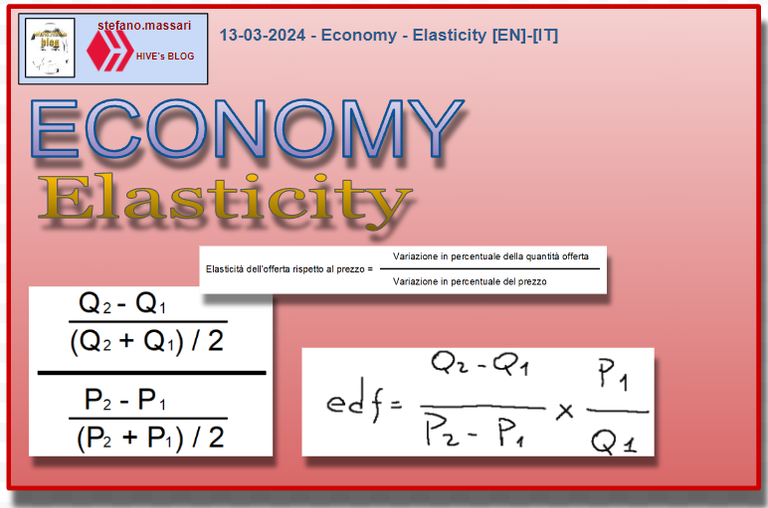
~~~ La versione in italiano inizia subito dopo la versione in inglese ~~~
ENGLISH
13-03-2024 - Economy - Elasticity [EN]-[IT]
Elasticity
Basic concepts
Supply and demand are the forces that regulate the market and are composed of price and quantity
Correlations:
If we take supply into consideration there is a direct correlation between price and quantity
However, considering demand there is an inverse correlation between price and quantity.
These factors serve us to analyze the market, but they are not sufficient to analyze the market in detail. To better understand the market we need to consider its price elasticity. It will be the elasticity that will make us better understand how the market can react based on the increase and decrease in price.
Elasticity
Elasticity can be sensitive and inelastic
When the elasticity is elastic with respect to the price it is said to be sensitive
When elasticity is not sensitive to price it is said to be inelastic
It can take on values greater or less than 1
We can say that elasticity depends on the speed with which sellers are able to adapt to the new price through the quantity placed on the market.
The determinants of elasticity
Listed below are the factors that determine the elasticity of supply with respect to price:
-The time horizon
-The production capacity
-The size of the company and the sector
-The mobility of production factors
-Easy storage and accumulation of stocks
Calculation of elasticity
The price elasticity of supply is the percentage change in quantity supplied divided by the percentage change in price.

Mathematically we can describe the situation as follows:
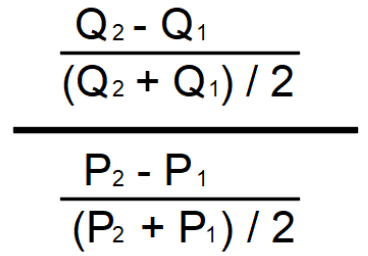
Where:
Q = Quantity supplied
P = Price
If the demand curve is not linear the formula will become as follows:

Exercise:
Taking these data into account:

Let's try to calculate:
-The percentage change in quantity
-The percentage change in price
-The elasticity of supply with respect to price
The percentage change in quantity
The percentage change in price
The price elasticity of supply
The percentage change in quantity

The percentage change in price
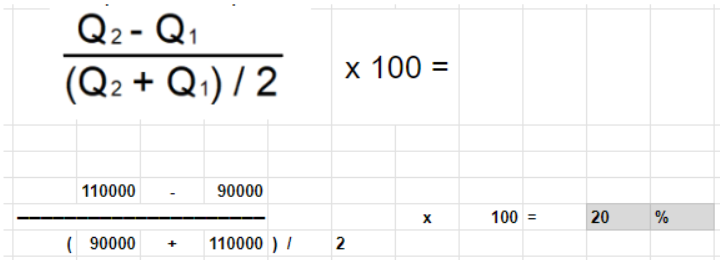
The price elasticity of supply

Point elasticity of demand
The punctual elasticity of demand is calculated with the following formula
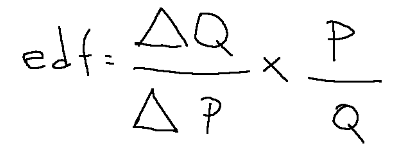
Where:
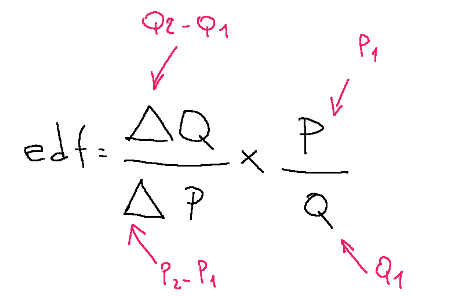
Definitely

Conclusions
In particular, elasticity measures consumers' willingness and preferences regarding the products to purchase when the price changes.
Request
Have you ever tried to analyze market data? Have you already heard of elasticity when analyzing supply and demand?

ITALIAN
13-03-2024 - Economia - Elasticità [EN]-[IT]
Elasticità
Concetti base
La domanda e l’offerta sono le forze che regolano il mercato e sono composte da prezzo e quantità
Correlazioni:
Se prendiamo in considerazione l’offerta c’è una correlazione diretta tra prezzo e quantità
Invece considerando la domanda c’è una correlazione inversa tra prezzo e quantità.
Questi fattori ci servono per analizzare il mercato, ma non sono sufficienti per analizzare il mercato in dettaglio. Per capire meglio il mercato abbiamo bisogno di considerare la sua elasticità nei confronti del prezzo. Sarà l’elasticità che ci farà comprendere meglio come può reagire il mercato sulla base dell’aumento e della diminuzione del prezzo.
Elasticità
L’elasticità può essere sensibile e anelastica
Quando l’elasticità è elastica rispetto al prezzo si dice sensibile
Quando l’elasticità non è sensibile rispetto al prezzo si dice anelastica
Essa può assumere valori maggiori o minori di 1
Possiamo dire che l’elasticità dipende dalla rapidità con la quale i venditori sono in grado di adeguarsi al nuovo prezzo attraverso la quantità immessa sul mercato.
Le determinanti dell’elasticità
Qui di seguito sono elencati i fattori che determinano l’elasticità dell’offerta rispetto al prezzo:
-L’orizzonte temporale
-La capacità produttiva
-Le dimensioni dell’impresa e del settore
-La mobilità dei fattori di produzione
-Facilità di immagazzinamento ed accumulazione delle scorte
Calcolo dell’elasticità
L’elasticità dell’offerta rispetto al prezzo è la variazione in percentuale della quantità offerta fratto la variazione in percentuale del prezzo.

Matematicamente possiamo descrive la situazione come segue:

Dove:
Q = Quantità offerta
P = Prezzo
Se la curva della domanda non è lineare la formula diventerà come segue:

Esercizio:
Tenendo conto di questi dati:

Proviamo a calcolare:
-La variazione percentuale della quantità
-La variazione percentuale del prezzo
-L’elasticità dell'offerta rispetto al prezzo
La variazione percentuale della quantità
La variazione percentuale del prezzo
L’elasticità dell'offerta rispetto al prezzo
La variazione percentuale della quantità

La variazione percentuale del prezzo

L’elasticità dell'offerta rispetto al prezzo

Elasticità puntuale della domanda
L’elasticità puntuale della domanda si calcola con la seguente formula

Dove:

In definitiva

Conclusioni
In particolare, l’elasticità misura la volontà e le preferenze dei consumatori circa i prodotti da acquistare al variare del prezzo.
Domanda
Avete mai provato ad analizzare dei dati di mercato? Avete già sentito parlare di elasticità durante un'analisi tra domanda e offerta?
THE END
Wow the formula is actually huge and at first I was thinking if it will be difficult to understand
Thanks for being here. Market forces are supply and demand and are made up of price and quantity. However, supply can be elastic if it is sensitive or inelastic if it is not sensitive
Elasticity in economics is somewhat different from the one we have in physics but I understand it more than that of physics
Thanks for being here. Elasticity in economics is different from that in physics. The elasticity of supply depends on how quickly sellers are able to adapt to the new price
To some extent I guess the elasticity in economics is different from the one of physics
Of course, elasticity in economics is something different from the elasticity we have in physics. Elasticity in economics is calculated through the ratio between the percentage change in quantity supplied and the percentage change in price. The elasticity of supply depends on the speed with which sellers are able to adapt to the new price !LUV
biyimi, stefano.massari sent you LUV. 🙂 (1/5) tools | trade | connect | wiki | daily
Made with LUV by crrdlx.
!DHEDGE
!WINE
!discovery 25
Ciao Liberty, grazie per il sostegno. Grazie per essere qui. L’elasticità in economia è diversa da quella della fisica. L’elasticità dell’offerta dipende dalla rapidità con la quale i venditori sono in grado di adeguarsi al nuovo prezzo attraverso la quantità messa sul mercato
This post was shared and voted inside the discord by the curators team of discovery-it
Join our Community and follow our Curation Trail
Discovery-it is also a Witness, vote for us here
Delegate to us for passive income. Check our 80% fee-back Program
Thanks for support